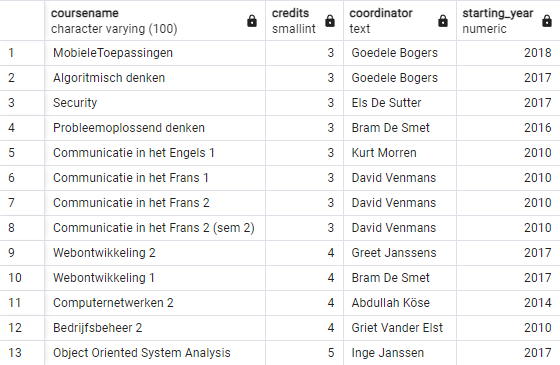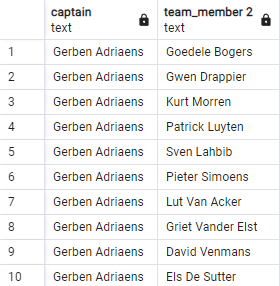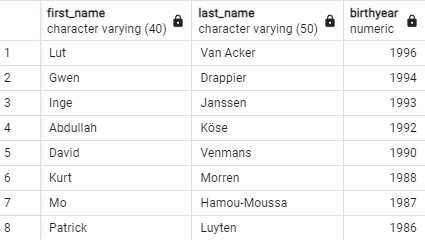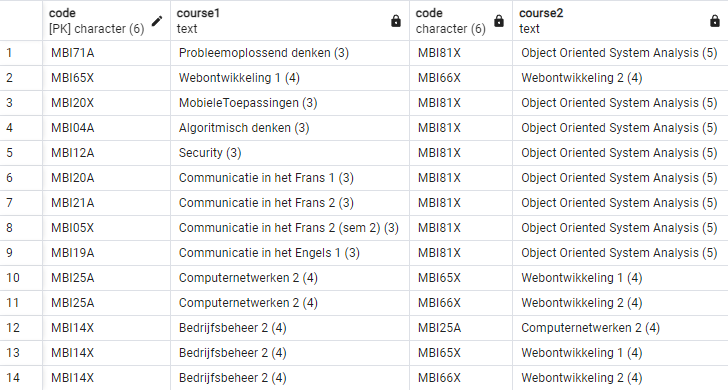No night of drinking or drugs or sex could ever compare to a long evening of productive hacking.
—Lynn Voedisch
Combining tables with INNER JOIN
In previous chapters, all components of a SELECT query have been
have been reviewed, except for one: the FROM component. There
wasn't much to say about it either, since we only queried one table. In this
section, we use multiple tables in a query, so that we can combine the information
in those tables.
The video explains the principles of the cartesian product and join. Watch it first, then follow the text below and make the exercises.
Implicit JOIN
We'll use a simple example to explain the principle. Suppose that you want a list of the mail addresses of all course coordinators as in the figure below. After the previous chapter you should have two linked tables in your own schema: ‘lecturer’ and ‘course’.

Now work out the following example by trying out the code of all the steps in your own schema. Do not forget to specify the name of your schema for each table, or set your search_path correctly. In the code examples below we chose the latter solution.
Cartesian product of multiple tables
The lecturer table contains 18 rows, which you can easily check with a COUNT(*) can check:
SELECT COUNT(*)
FROM lecturer;How many rows does the table ‘course’ contain?
This table contains 21 rows.
Now try out the following code and try to figure out from the output what it does:
SELECT *
FROM lecturer, course;
By specifying in the FROM component two tables (separated
by a comma)
each row of the table ‘lecturer’ becomes linked to each row of the
second table ‘course’
. Each of the 18 lecturer rows is thus combined with each of the
21 courses. That gives a total of 18 × 21 = 378 rows in the result.
You will need the horizontal scroll bar in the result field, because
these rows will be quite long since all the columns of both tables
together are present in the result.
This product – a set in which each row from the first table occurs with
each row from the second table – is called the cartesian product.
Listing two tables after the word FROM is an
implicit join. We will later ask to always use an explicit join, but for now we'll do it this way.
Selecting columns in the cartesian product
You know that the FROM component is always ran first. In this case, it loads the cartesian product of both tables into the
working memory. The SELECT comes later. It selects certain columns.
Try this code:
SELECT code, coordinator, lecturer_id, email
FROM lecturer, course;
Now suppose that, in addition to these four columns, you also want to
show the start date of the course, a simple addition of this column in
the SELECT …
SELECT code, coordinator, lecturer_id, email, start_date
FROM lecturer, course;... you would think. However, you get an error message:
ERROR: column reference "start_date" is ambiguous
LINE 3: SELECT code, coordinator, lecturer_id, email, start_date
What goes wrong? Then modify the SELECT so that you also see
the start_date.
The database server informs you that the requested column ‘start_date’
is ambiguous. In fact, there are two columns ‘start_date’. You can
remove this ambiguity by prefixing the name of the column with the
name of the table, i.e. something in the style of SELECT table_name.column°name. If there is no ambiguity, the column name is of course sufficient!
This could then be a possible solution:
SELECT code, coordinator, lecturer_id, email, course.start_date
FROM lecturer, course;Alias for table names
You'll notice that you have to regularly specify the column by writing the table name in front of it. That's a fair amount of typing. A shorter option is to use an alias. You temporarily replace the name of the table with something shorter (often only one or a few letters). Compare subsequent versions of the same query. First the long version:
SELECT code, course.name, coordinator, lecturer_id, lecturer.last_name, email
FROM lecturer, course;Shorter and therefore possibly easier to read is this version with two aliases:
SELECT code, O.name, coordinator, lecturer_id, L.last_name, email
FROM lecturer AS L, course AS O;
You may omit the word AS and so the query gets even shorter:
SELECT code, O.name, coordinator, lecturer_id, L.last_name, email
FROM lecturer L, course O;
Try making the combination where you define an alias, but
still use the full name of the table in the SELECT by testing
out the following code:
SELECT code, course.name, coordinator, lecturer_id, L.last_name, email
FROM lecturer L, course O;The error message will help you further:
ERROR: invalid reference to FROM-clause entry for table "course"
LINE 2: SELECT code, course.name, coordinator, lectu...
^
HINT: Perhaps you meant to reference the table alias "o".
SQL state: 42P01
Character: 50Specifically, this means that once you have defined an alias for a table name, you are obliged to use that alias. At that point, the table name is temporarily replaced by the alias!
Join condition
Because of the implicit join in the FROM component, you created
the
cartesian product: a combination of each row of one table with
each row of the second table. So a total of 378 rows. You must now limit
that long list to the ‘meaningful’ rows. Removing or keeping rows is done
with a WHERE. This WHERE is called the ‘join condition’.
What are the sensible rows here? Each coordinator of each course will be paired with any lecturer. However, we were only looking for the email address of the coordinator. The only meaningful rows then are those where the coordinator in the course table equals the lecturer_id in the lecturer table:
SELECT code, email
FROM lecturer, course
WHERE coordinator = lecturer_id; -- join conditionOf the 378 rows in the cartesian product, only 21 satisfy this condition. This makes sense: there are 21 courses and each course has precisely one coordinator. The figure at the beginning of this chapter shows the result in pgAdmin.
This exercise covers a lot of things from previous chapters. Write the query that, for each course of less than 6 credits, returns the following: the name of the course, the number of credits, first name and last name of the coordinator in one column, and the year in which that course was first on the program. Sort according to increasing number of credits. For equal number of credits, continue sorting according to year (newest first). You should obtain the following figure with a table of 13 rows.

SELECT O.name AS coursename, credits, L.first_name || ' ' || L.last_name AS coordinator,
EXTRACT(YEAR FROM O.start_date) as starting_year
FROM lecturer L, course O
WHERE coordinator = lecturer_id AND credits < 6
ORDER BY 2 ASC, 4 DESC;Explicit JOIN
The previous exercise exposes a weakness of the implicit join (multiple tables in the FROM separated by a comma). Both the join condition(coordinator = lecturer_id) and the ‘normal’ condition (credits < 6) are in the WHERE component. An alternative notation exists for
the
JOIN where you explicitly name this operation that way.
The solution of the previous exercise then looks like this with an
explicit JOIN:
SELECT O.name AS coursename, credits, L.first_name || ' ' || L.last_name AS coordinator,
EXTRACT(YEAR FROM O.start_date) as starting_year
FROM lecturer L INNER JOIN course O ON coordinator = lecturer_id -- more readable!
WHERE credits < 6
ORDER BY 2 ASC, 4 DESC;
The join condition is now in the FROM and we explicitly state
the word JOIN. This notation is more logical and you are less
likely to forget the join condition or doing something wrong in the WHERE, because this component is now simpler.
The order in which you write the tables is not important. The word INNERcan be omitted. We recommend always writing it anyway. In fact,
there is also an OUTER JOIN.
There is also an alternative notation for the join condition that you can use use if both columns in that condition have identically the same name and if you are testing for equality of both. It is not the case in this example, but suppose that the column ‘coordinator’ also had ‘lecturer_id’ as its name, then we could have written the above code like this:
SELECT O.name AS coursename, credits, L.first_name || ' ' || L.last_name AS coordinator,
EXTRACT(YEAR FROM O.start_date) as starting_year
FROM lecturer L INNER JOIN course O ON O.lecturer_id = L.lecturer_id. -- alias necessary!
WHERE credits < 6
ORDER BY 2 ASC, 4 DESC;
This can be written somewhat shorter by using USING:
SELECT O.name AS coursename, credits, L.first_name || ' ' || L.last_name AS coordinator,
EXTRACT(YEAR FROM O.start_date) as starting_year
FROM lecturer L INNER JOIN course O USING(lecturer_id)
WHERE credits < 6
ORDER BY 2 ASC, 4 DESC;
We will return to this later in the exercises. The notation with ON is always usable, the one with USING only in certain cases.
Joining a table with itself
In a JOIN operation, you combine two (or more) tables. You may
also use the same table two times. The use of aliases is
mandatory in this case. Try the following exercise using the tips.
For a competition, lecturers form a team of two. One person is the captain of the team; the other is then just a team member. Write the query that generates a list of all possible teams as shown in accompanying figure. This list contains 306 rows. Some tips:
-
The first team member is in the table ‘lecturer’, so is the second
team member. So you do an
INNER JOINof the table ‘lecturer’ with itself. - You will have to distinguish between the first table ‘lecturer’ and the second table ‘lecturer’. Use as aliases e.g. ‘L1’ and ‘L2’.
- What will be the join condition? You cannot form a team with yourself ...
- Note the column headings in the figure.

SELECT L1.first_name || ' ' || L1.last_name AS captain,
L2.first_name || ' ' || L2.last_name AS "team_member 2"
FROM lecturer L1 INNER JOIN lecturer L2 on L1.lecturer_id != L2.lecturer_id;We extend the previous exercise a bit:
We still want a list of possible teams of lecturers, but with the additional condition that both team members must live in the same municipality. You will now only be able to create 6 possible teams. Also show the municipality.
SELECT L1.first_name || ' ' || L1.last_name AS "captain",
L2.first_name || ' ' || L2.last_name AS "team_member 2", L1.municipality
FROM lecturer L1 INNER JOIN lecturer L2 on
L1.lecturer_id != L2.lecturer_id AND L1.municipality = L2.municipality;Exercises
Which courses currently in the program have a coordinator who lives in a municipality whose zip code begins with ‘3’. Write the SQL query that generates the figure below. No sorting is required.

SELECT code, O.name, lecturer_id, first_name, L.last_name, municipality
FROM course O INNER JOIN lecturer L on O.coordinator = L.lecturer_id
WHERE municipality LIKE '3%' AND O.end_date IS NULL;
Write the SQL query that generates the list (see figure) of all the
lecturers who are younger than Gerben Adriaens. This list is sorted so
that the youngest lecturer is at the top. You may assume that there is
only one Gerben Adriaens. You may not first query the date of birth of Gerben Adriaens. Subqueries are not allowed either, because we haven't studied those
(yet). It can be done with one query by using a JOIN.
Also note the column header (as always).

You can join the table ‘lecturer’ with itself. Note the special
condition in the join condition. If you want to better see what
happens, you should ask for a SELECT * so that you can inspect
the fullrow. The WHERE tests for who is younger.
You are younger if your date of birth is greater.
SELECT L1.first_name, L1.last_name, EXTRACT(YEAR FROM L1.birthdate) AS birthyear
FROM lecturer L1 INNER JOIN lecturer Adr ON Adr.last_name = 'Adriaens' AND Adr.first_name = 'Gerben'
WHERE L1.birthdate > Adr.birthdate
ORDER BY 3 DESC;A student is still 8 credits short of graduation. Generate a list (see figure below) of all possible combinations of 2 courses from the old program (courses that are now no longer given) that together represent 8 credits. Chances are that you will obtain a list where each combination appears twice (if A and B together are 8 credits, then B and A are also 8 credits and then there are two rows with the same two courses in a different order). Can you find a trick to avoid these duplicates? No need to sort.

SELECT O1.code, O1.name || ' (' || O1.credits ||')' AS course1,
O2.code, O2.name || ' (' || O2.credits ||')' AS course2
FROM course O1 INNER JOIN course O2 on O1.code != O2.code
WHERE O1.credits + O2.credits = 8 AND
O1.end_date IS NOT NULL AND
O2.end_date IS NOT NULL AND
O1.code < O2.code; -- trick to filter out the duplicatesExercises SQLzoo
Schema ‘Euro2012’
An interesting exercise series on SQLzoo uses data from the the European football championship in 2012. The logic model on SQLzoo's site that accompanies this exercise, has a somewhat different notation. Therefore, we recreated it according to our conventions:
A word about this model:
- The schema contains three tables: ‘game’ (contains information about each game, such as time, stage and between which teams), ‘eteam’ (name and coach of each team) and finally a table ‘goal’ (who scored a goal in which minute for which team).
- Note that the primary key of the table ‘goal‘ is a composite key (twice PK in the table): after all, there may be multiple goals per match, after all, and so matchid alone would be be insufficient to uniquely specify a goal. The combination of matchid and gtime (minute in which the goal was scored) is unique (if you assume that goals cannot be scored twice in the same minute 😀).
- The table ‘game’ has two foreign keys, numbered FK1 and FK2. After all, a game is played between two teams, and each field (‘team1’ and ‘team2’) thus refers to a particular team about which you can find more information in the table ‘eteam’).
- Moreover, you must be able to read the cardinalities well in this logical schema. The large green ellipse tells you –if you look from ‘eteam’ to ‘game’– that each team plays at least one game. The smaller orange ellipse indicates that a game is played by one unique team1 and one unique team2.
Exercises on INNER JOIN
Note on this exercise set: on SQLzoo's site, they use JOIN without
the word INNER every time. We prefer the full name, so preferably
always write INNER JOIN.
Complete exercise sequence 6 on JOIN. Small remark: exercise 13 is not solvable with an INNER JOIN, it needs an OUTER JOIN. You can skip this exercise.